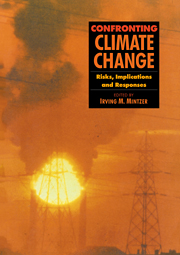Book contents
- Frontmatter
- Contents
- Foreword
- Acknowledgements
- List of Reviewers
- 1 Living in a Warming World
- I The Science of Climate Change
- II Impacts of Global Climate Change
- III Energy Use and Technology
- IV Economics and the Role of Institutions
- V Equity Considerations and Future Negotiations
- 21 Sharing the Burden
- 22 Climate Negotiations: the North/South Perspective
- 23 Shaping Institutions to Build New Partnerships: Lessons from the Past and a Vision for the Future
- Annex I
- Annex II
- Glossary
- Index
21 - Sharing the Burden
Published online by Cambridge University Press: 06 January 2010
- Frontmatter
- Contents
- Foreword
- Acknowledgements
- List of Reviewers
- 1 Living in a Warming World
- I The Science of Climate Change
- II Impacts of Global Climate Change
- III Energy Use and Technology
- IV Economics and the Role of Institutions
- V Equity Considerations and Future Negotiations
- 21 Sharing the Burden
- 22 Climate Negotiations: the North/South Perspective
- 23 Shaping Institutions to Build New Partnerships: Lessons from the Past and a Vision for the Future
- Annex I
- Annex II
- Glossary
- Index
Summary
Editor's Introduction
The world is moving toward a negotiated international agreement to limit the risks of rapid climate change and to minimize the associated damages. In the process, several nagging and complex questions emerge repeatedly. These questions cannot be resolved through any scientific experiment or computer simulation, but they are all critical to any effective new bargain. How will responsibility for the buildup of greenhouse gases in the atmosphere be established among countries? How will the targets for future emissions reductions and the (limited) rights to increases in future emissions be allocated? And how will the burden of future costs be distributed equitably?
Michael Grubb, James Sebenius, Antonio Magalhaes and Susan Subak offer a sound and cogent basis for addressing these questions. They begin by reviewing “the facts”: the available data on past and current emissions of the most important greenhouse gases. Noting the weaknesses and limitations of these data, Grubb et al. observe that industrial countries have contributed disproportionately to past emissions, both in aggregate and per capita. This is especially true for emissions of carbon dioxide and chlorofluorocarbons — the most important anthropogenic contributions to the risks of rapid climate change. The pattern continues to the present day; emissions from industrial nations account for about 75% of the fossil-fuel-derived carbon dioxide in the atmosphere. But the increasing emissions from agricultural and forestry activities, and the pressure of growing population, suggest that the South cannot evade future responsibility for the problem, any more than the North can. How, then, can nations share the burden equitably?
Grubb et al. catalogue, evaluate and compare a wide range of rationales for dividing emission rights among the members of the world community.
- Type
- Chapter
- Information
- Confronting Climate ChangeRisks, Implications and Responses, pp. 305 - 322Publisher: Cambridge University PressPrint publication year: 1992
- 24
- Cited by

